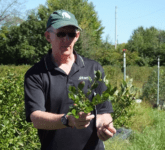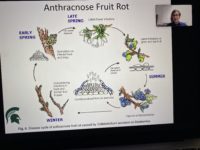Jul 14, 2022Pest, disease controls keep Michigan blueberry growers busy
An online survey of Michigan blueberry growers confirmed the biggest challenges in 2021 involved insect control, with nearly 22% of respondents listing it as the top issue.
But disease management challenges were quickly cropping up as a major concern.
The survey results were shared by Michigan State University (MSU) Small Fruit Program specialists Carlos Garcia-Salazar, Rufus Isaacs and Timothy Miles during the 2022 Pre-Bloom Blueberry Meeting in May in a hybrid format of in-person and online audiences.


Other grower problems that received mention were marketing (19%), lack of labor (16%), disease control (12%), summer drought (10%), spring frost (9%), winter damage (8%) and food safety (4%).
The online survey had about a 12% response rate, Garcia said, and brought 55 grower responses.
“One thing I like is the responses come from the same growers every year, so we know that we are making progress,” Garcia-Salazar said.
Nearly 4,900 acres of blueberries were represented in the survey. Blueberries surveyed represented 22% of the Michigan blueberry planted area. The total production value was calculated at $9.6 million.
A total of 2,242 blueberry acres were harvested, with production at about 12 million pounds. The yield per acre in 2021 was 5,370 pounds per acre. The average price per pound for fresh blueberries (53% of the crop) was $1.50. They represented $9.6 million in production value.
The total 2021 production value for the surveyed crop was calculated at $11.8 million.
The average price per pound for processing blueberries (47% per crop) was 45 cents.
SWD and other pests
Spotted wing drosophila (SWD) remained a top pest concern for growers, who used a variety of insecticides to ward off the fruit fly. D. suzukii, originally from southeast Asia, has become a major pest species in America and Europe, because it infests fruit early during the ripening stage, in contrast with other drosophila species that generally infest only rotting fruit.
The survey determined Mustang Maxx (21%) was the most frequent pesticide used by growers for SWD. It was followed by Imidan (18%), Entrust (13%) and Malathion (12%).
At least 50% of the growers reported seven seasonal applications of pesticide for SWD.
“In 2000 we used an average of eight applications, so we were able to save one application in 2021,” Garcia-Salazar said.
Mustang Maxx was applied the most frequently (an average of 2.94 times) during the season for SWD, followed by Imidan (2.7), Malathion (1.9), Lannate (1.8), Brigade (1.4), Entrust (1.29), Hero (0.8) and Danitol (0.6).
Blueberry stem gall wasp (BSGW) was another pest challenge in 2021, with 1,115 of the surveyed acres reportedly infested. The varieties receiving treatments for BSGW were Jersey (330 acres), Liberty (162 acres) and other varieties (623 acres). Top pesticides used for the pest were Lannate (32%), Mustang Maxx (30%), Sivento (15%), Lannate+Mustang Maxx (15%) and Exerel (9%).
Garcia-Salazar said that some processors are going to stop taking Jerseys, due to high rates of gall wasp on that variety.
“Some growers have just decided to renovate, and take (Jerseys) out of the field. One thing I saw this season after doing some scouting is I’ve seen more Duke affected by the gall wasp,” he said.
According to the survey, growers looking for integrated pest management information went to MSU sources 90% of the time.
“That makes us feel real good and shows the information we are providing is the best source for growers and that we are making a difference,” Garcia-Salazar said. “And, 80% of the growers are interested in receiving more information on pest management.”
When asked about percentages of fruit loss from SWD, including downgrading, 75% of the 2021 respondents indicated there were few problems.
“That shows that things are improving,” Garcia-Salazar said. “There was a time when 50% of the growers indicated fruit loss from spotted wing drosophila.”
Controlling SWD is not cheap, however. The survey showed SWD management cost $158 per acre in 2021, with 50% of the growers spending at least $112 per acre.
BSGW control expenses were at $111 per acre, with 50% of the respondents spending at least $100 per acre.
“We’re becoming very efficient in the use of pest management insecticides,” Garcia-Salazar said. “Now disease management is where we have an issue.”
Expenses for disease management, especially in the fruit rots, were bigger than they were for spotted wing drosophila. Disease management cost $213 per acre, with 50% spending $200 per acre.
Gall wasp infestation
MSU’s Isaacs offered some suggestions to curtail gall wasp infestation.
Resistant cultivars should be grown, especially because the BSGW is “much tougher to control in Jersey.”
Growers must prune along with destroying the galls.
Chemical control against wasps and eggs include the following approaches:
- Immediate post-bloom application, once honeybees are removed.
- Focus on coverage: high volume (60 gallons per acre or higher), with penetrant.
- Lannate, Imidan, Verdepryn, Exirel and Movento are very active.
- Add a second spray one week later or combine treatments.
- This is also during fruitworm and aphid control timing.
Isaacs noted that researchers have released Michigan Blueberry Facts: Biology and Management of Stem Gall Wasp in Highbush Blueberries (E3443). It is available at: https://www.canr.msu.edu/resources/michigan-blueberry-facts-stem-gall-wasp-e3443.
Cranberry fruitworm control
Isaacs also noted it’s important to monitor for cranberry fruitworm with pheromone monitoring traps.
Growers also should:
- Check traps frequently for moths to set biofix.
- Prevent infestation through model-driven timing of sprays to protect berries.
When doing this, consider bee safety. During bloom, use Bacillus thuringiensis (Bt) products. After bloom, pursue broad spectrum options, including Exirel, Grandevo and Verdepryn.
An immediate post-bloom spray is most critical, Isaacs said.
Targeting disease
Shay Shemanski, a plant pathology Ph.D. student in Tim Miles’ lab for the past three years, focused his presentation during the pre-bloom event on mummy berry and anthracnose management.


In 2020, nearly one-third of Michigan blueberry growers indicated anthracnose fruit rot was the top disease problem they faced.
Shemanski outlined some basic cultural practices that help control diseases in blueberries, including pruning, mulching, drip irrigation, adjusting overhead irrigation timing to minimize wetness and wider plant spacing.
“Minimizing wetness for control of disease is essential,” Shemanski said. “This helps prevent disease from jumping easily between bushes.”
Shemanski said anthracnose fruit rot is caused by Colletotrichum acutatum and accounts for about 40-50% of fungicides used in Michigan blueberries.
Anthracnose can reduce yield, shelf life and fruit quality and can lead to unacceptable microbial levels. Preharvest losses of 10-20% annually have been reported, and postharvest losses in storage can approach 100%.
Shemanski said anthracnose is primarily controlled with synthetic products, including Switch, Abound and Pristine. Some biologicals are available, including Lifegard, Stargus and Double Nickel. There is Frac 11 fungicide resistance throughout Michigan.
Anthracnose management options in the early season include pruning and planting resistant varieties (such as Elliott). Mid-season controls should focus on using a preventative spray program (several fungicides are available), harvest quickly and keep fruit cool, and don’t harvest when it is raining or if the fruit is wet, if possible.
Protecting pollinators
Ana Heck, MSU Apiculture Extension educator, talked about honeybee and pollinator stewardship.
Good conditions for bees to pollinate include having healthy and sufficient bees and good weather (warm/hot, not raining or extremely windy), Heck said. It’s important to have a strong population of forages in honeybee colonies.
MSU’s Blueberry Pollinator Stewardship Guide offers these key recommendations for protecting an investment in pollination:
- Use integrated pest management strategies to reduce pesticide exposure to bees.
- Minimize the use of insecticides and fungicides during bloom.
- Support bee health by establishing bee foraging plantings on your farm
- Learn about bees and share what you know.
- Communicate with your beekeeper about bee health and pesticides.
“Learn about bees and share what you know,” Heck said. “Communicate with your beekeeper about bee health and pesticide applications.”
—Gary Pullano, Senior Correspondent














